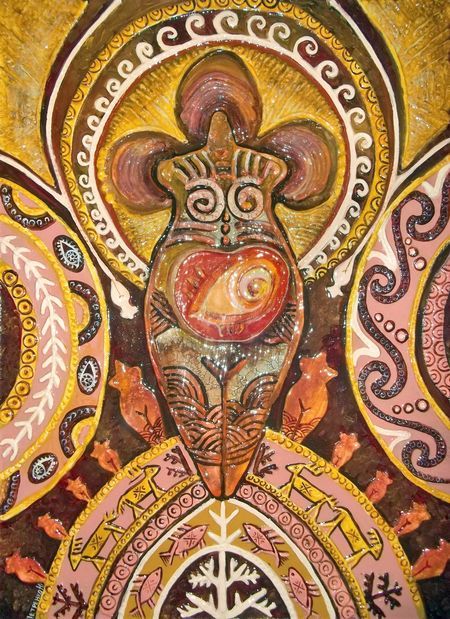Art work made of salt dough
In her creative work Yulia Petrenko continues old traditions of decorative and applied art of Ukraine
Creative world of Yulia Petrenko, artist from Nizhyn, is extremely bright, warm, and touching. Even if you see her artwork for the first time you get the feeling that you’ve known the artist for a long time because the themes she refers to in her work are close to any modern person.
Petrenko grew an active and curious child. She had dancing classes, went to music school, but most of all she loved painting in the Art School at Maria Zankovetska School of Culture and Art in Nizhyn. Both her teachers and parents got accustomed with the fact that all of Yulia’s notebooks, journals, book covers, and wallpapers at home had drawings all over them. Another thing that brought Petrenko great joy was watching old ladies. Yulia’s great-grandmother Maria was the first who showed the girl how to draw figures of amazing fantasy creatures on paper. Yevdokia masterfully embroiders carpets, designs ornaments. Sophia likes weaving, embroidering, and singing.
Therefore, nobody was surprised when Yulia entered the Arts and Crafts Department of Nizhyn School of Culture and Arts named after Maria Zankovetska. Then she studied at the Department of Art Ceramics of the Lviv National Academy of Arts.
Even though Petrenko first learned painting through academic art, decorative art was something closer to her. “Old embroidery patterns, painted eggs, ornaments on household items have such deep things coded in them that it would take a lifetime to solve them all,” believes Petrenko.
When she was still a high school student on a trip to Lviv Petrenko visited an exhibition of art works by Maria Pryimachenko, who greatly impressed the young girl with her sincerity, warmth, and love to the world around her. After Petrenko learned more about primitivism – art work of Maria Pryimachenko, Fedir Pryimachenko, Nykyfor, and Niko Pirosmani, she felt that this art, full of love for life, touched her soul and bewildered her to some extent.
Plunging into the depth of the ages, Petrenko became interested in a variety of figures that serve as amulets. Archeologists, when they found such artifacts, at first could not understand what they were made of – whether they were made of bone or stone. Finally they discovered that the figures were made of dough mixed from flour of first grinding and salt. The amulets were kept in the corner with icons during the whole year and then they were buried in the soil for a new crop. Over time the salt dough hardened and became as hard as mineral. Petrenko was so impressed by this ancient technique that she decided to try it out herself. She came up with her own special recipe for making amulets from salt dough with chemical additives.
Applying the knowledge and skills acquired during her studies at the department of ceramics, the artist decided to create decorative panels using tightly mixed dough or bioplastics instead of clay. Such panels are also called “volumetric painting” or “false majolica.”
At the present moment there is an entire collection of such bas-relief panels made by Petrenko. They all could be thematically divided into several groups: artworks based on Taras Shevchenko writings: Naimychka (The Servant Girl), Zapovit (Testament), Topolia (Poplar Tree); Mykola Hohol writing: The Fair at Sorochyntsi, Night before Christmas, Viy, and Terrible Vengeance; philosophical reflections; religious reflections; and folk traditions.
The artist says that she gets the inspiration for creating her panels of salt dough from nearly everything that surrounds her: nature, people’s relations, events that take place in the society. Themes from the lives of our ancestors and family roots especially prompt the artist to action.
Petrenko combines creative work with teaching. She is now a methodologist teacher at Nizhyn School of Culture and Arts. The artist and teacher wrote six text books especially for her colleagues and students: Modeling – the First Step to Learning Culture, Arts and Crafts, Working with Natural Materials, Fine Art in School and books: My First Book about Drawing and Berehynia. World of Volumes. Bioplastics. Modeling of Salt Dough. In the preface to the latest book Petrenko wrote that her goal is “to help a person feel the world view of his ancestors, the ancient Ukrainian people, touch the origins of his people, get closer to their traditions and culture, tell him about the folk legends, myths, crafts, and rituals, about arts and crafts in general, as well as facilitate their revival and spread.”
Occasionally some of the fans of Petrenko’s art work ask her whether she does not regret spending so much time with children because she could use it for her artistic work, especially since there are very few artists who work in this technique. But Petrenko says that she cannot even imagine herself without her kids, just like they don’t see themselves without her: “Together with them I live in a different world – it is a world of imagination and dreams. Perhaps, it is hard to imagine for someone but I dissolve completely in this world.”
“Relief layers painted with bright colors and covered with varnish, remind hutsul tiles in the manner of execution and the somewhat naive interpretation of scenes. But instead of the traditionally baked clay we see quite an unusual material – salt dough,” art critic Yaroslav Kravchenko shared his impressions. “The scenes portrayed on her panels reflect the history of the region: armed Cossacks riding horses attack the defenders of the master’s castle and this is probably what the blind kobza player in the foreground of the panel sings in his song. Another panel shows a beautiful Ukrainian young woman frozen on her knees praying to the icons in an old wooden home, begging better fate for the betrayed Ukraine… Artistic skill, sense of color taste, lyricism in the interpretation of images are characteristic of the artist, who continues the old Ukrainian art and crafts traditions in her work.”






